
Rauw Alejandro’s Saturno Tour
In-the-round design compliments futuristic fashion, pounding dembow beats and an epic alien abduction.
"Part of what makes Billie so interesting, sonically and aesthetically, is her duality: the velvety voice that envelops you juxtaposed with these pounding beats. Both the moments of loudness and the subtleties of the production are paramount during lighting programming."
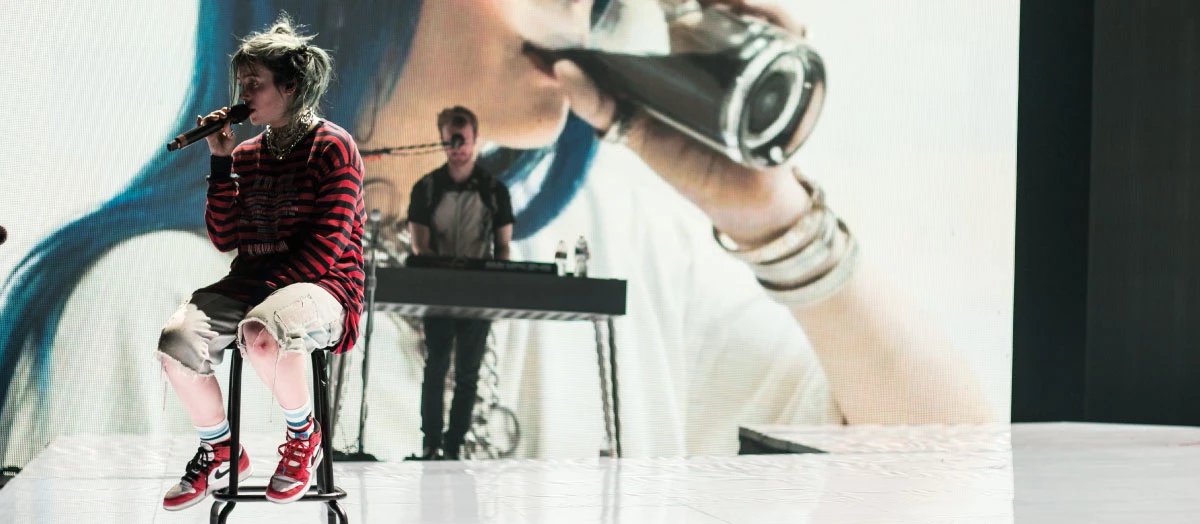
Photo credit: Jonathan Kingsbury
Billie Eilish is having quite the year, to such an extent, that introductions feel unnecessary. Her rise to fame has been chronicled extensively. The countless think pieces on her androgynous style, and how it makes her a very different kind of pop star - human and unpolished - but still impossibly cool. All the details of her extremely Los Angeles upbringing, how she was groomed for this - the homeschooling, the working actors for parents, the singing and dance lessons - have been detailed and shared. You know her brother’s name is Finneas, and that he’s in her band. You’ve probably heard that they recorded her entire debut album in his bedroom, how the songs sample broken glass and Easy-Bake Ovens. You know that she’s 17 years-old. You’ve been impressed by the subtlety in her vaporous voice, and either appalled or enamored with the candid self-deprecation in her lyrics.
What you probably haven’t heard about is the technical production and set design on her tour.
PRG and VER are providing lighting, rigging, LED, automation and cameras on Billie Eilish’s When We All Fall Asleep World Tour. We sat down to talk with the team that designed the sets, stage and lighting for her live performance. They delve into the creative process, gear and iterations it took to bring her visions, the stuff of dreams and nightmares, all around the world.
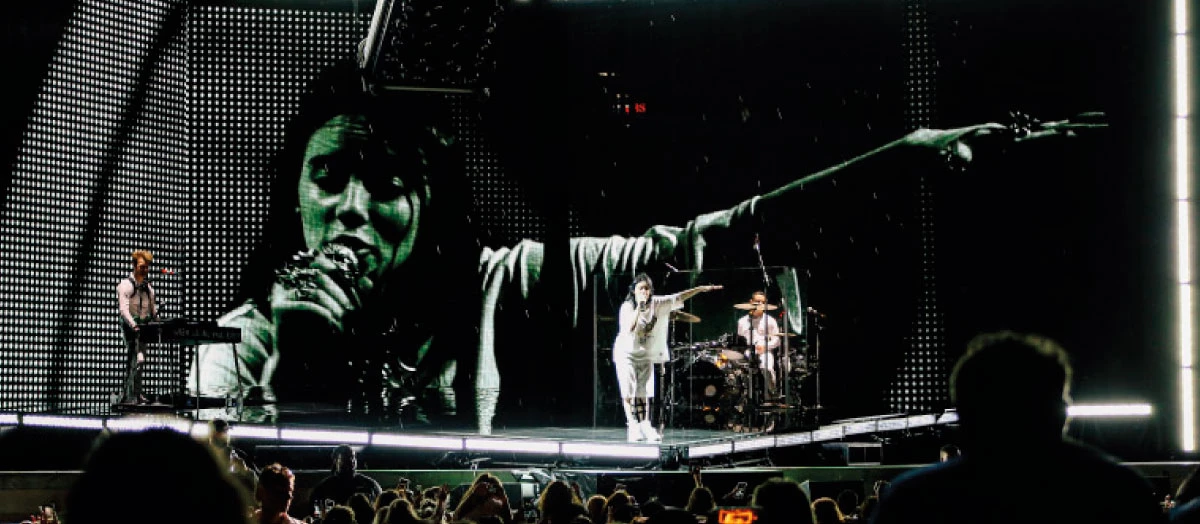
Photo credit: Melissa Madison Fuller
Early Creative Direction
Erik Anderson and Gordon Droitcour of Cour Design started working with Billie Eilish in late 2017, before anyone could write presumptuous introductory paragraphs about her like the one you just read.
The design duo has always been more solutions-focused. Their company started when they worked together to develop a way to trigger lighting using Ableton, which gave them early entry to the market of people doing automated lighting systems, and in turn, up and coming artists.
“The first tour we sent Billie on was with one of our automated systems and her dad was setting up the lighting because there was no LD to operate anything. Now she’s doing seven trucks. That’s happened in a 12-month period,” says Anderson, co-founder of Cour Design.
That 12-month period was the year 2018. That was the year Billie sold out her North American tour in under a minute. It was also the year her songs were streamed more than one billion times.
“If we are all being honest, she’s exceeded expectations. I’ve never seen it happen this quickly or organically. She built that momentum and it took off because she’s identifying with a fan base,” Anderson says.
From the logistics and design side, her rapid rise created a lot of challenges.
“You’re dealing with very short turnaround time and Billie is an artist who likes to be involved as much as she can,” Anderson continues. “She has a very particular idea of how she wants things to look and she knows her brand better than anyone else. It’s been exciting but also challenging from that perspective.”
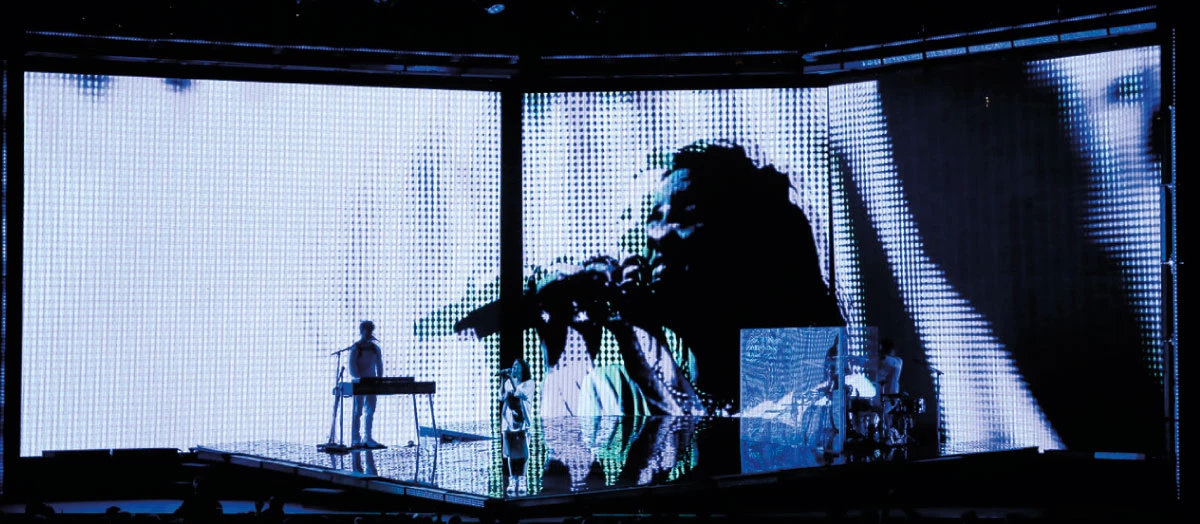
Photo credit: Melissa Madison Fuller
Worldwide 360 Solutions
“VER was with Billie from the beginning and we always push as much as we can to keep the artist working with that original team when they blow up,” Anderson says. “Account Executive Anthony “Looch” Ciampa worked hard to hit the numbers we needed to. It was obvious early on who was willing to invest and wanted to make this work.”
PRG and VER knew that Billie’s team had a lot on their plates tackling both Coachella and the tour, which had a hectic schedule jumping back and forth between Coachella, Australia, the United States and Europe.
“Having a single account representative we could go to and talk everything through with has been a huge time-saver for us,” explains Anderson. “It’s also been beneficial to have a company that has the ability to work with the numbers on lighting side so they can make the video side work and vice versa.”
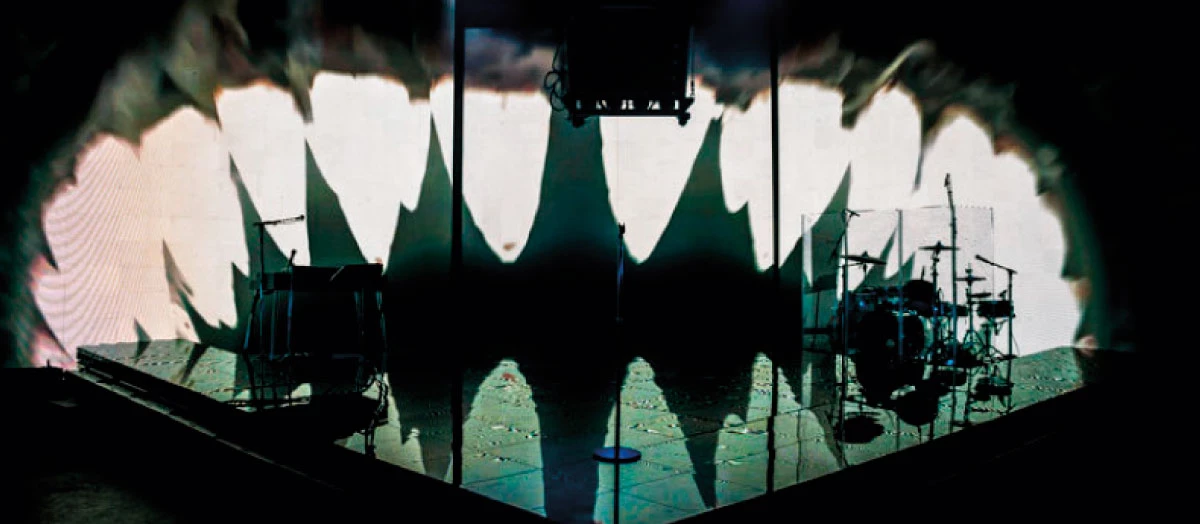
Photo credit: Jonathan Kingsbury
Cour Design partnered with Fireplay when it came time to debut Billie’s new, more involved touring design at Coachella. Led by Lighting Designer Nick Whitehouse, Fireplay is collaborative design and production studio that has worked with some of the biggest pop acts including Justin Timberlake and Kylie Minogue.
“We’ve been friends with Cour for a while and looking for a reason to work together,” says Whitehouse. “When they started work on the Billie project and it was growing so fast it was a good opportunity to do that.”
“The design side of it was a real collaboration,” Whitehouse says. “They had a concept they’d worked through with Billie, so we took it and put our Fireplay spin on it and added some elements that were unique.”
These Fireplay elements included taking the original concept, a flat wall with a riser in front of it and figuring out how to practically turn it 45 degrees into an opened cube with a video floor that surrounded Billie.
“Fireplay came and gave us some helpful tips on how to achieve the forced perspective with the raised floor,” explains Anderson. “We presented it to Billie the second week of February, knowing rehearsals started the second week of March. She was really happy with it from the beginning. We scrambled in every possible way to get it together and it’s been wild. We were able to pull together a really good team for content with us handling the creative direction for the show.”
LED, Scenic and Rigging
Lyrically and thematically, Billie and Finneas have created characters in many of her songs, including “Bad Guy” and “You Should See Me in a Crown.” They are playing with the identity mirrored in other aspects of her brand. Her vocals are often compared to Lana Del Rey, and her personal style to Tyler, the Creator. She contains multitudes.
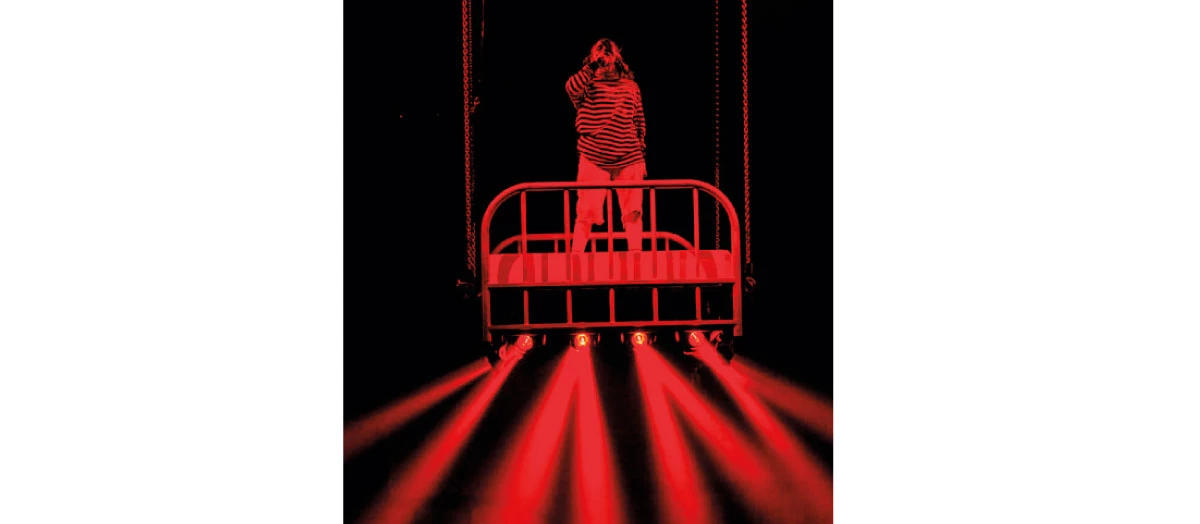
Photo credit: Jonathan Kingsbury
“We wanted to create this immersive video environment because every song is a different persona and a different feel,” says Whitehouse. “Content is created to reflect the mood of the music and to frame Billie in a different way for each single track, so we were able to do complete shifts for how the show looked and felt simply by changing the video content.”
Billie depicts herself as the monster under her bed for the debut album art and has an ongoing theme of nightmares and horror. A rigged bed that moved around the stage and took Billie midair became the ultimate, standout scenic element on the tour.
“She has a lot of ideas that came through in both the content and set pieces, the bed is definitely one of those. She was really involved in driving this forward and we were very happy with how that worked out,” says Whitehouse. “When she’s up there performing on it, that’s iconic. When you look at her trajectory and process as an artist, the way her production and album went down, those features are the ones that most associate her brand with what we’ve done, and to me, it’s the perfect design that fits with her story and everything she’s trying to do.”
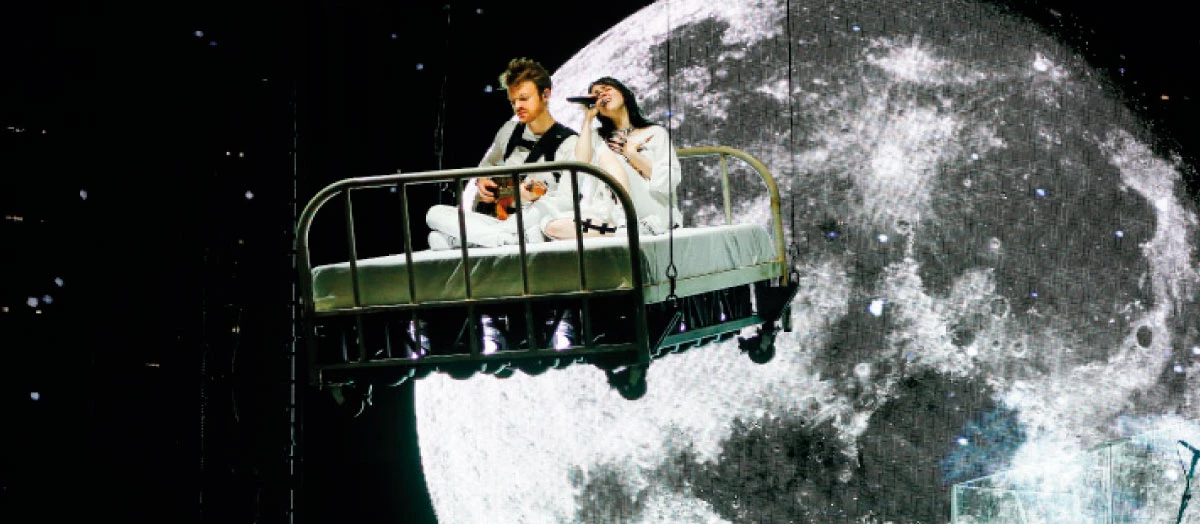
Photo credit: Melissa Madison Fuller
Lighting Design and Programming
Lighting Director Tony Caporale teamed up with Dominic Smith of Fireplay to program the show.
“Dominic has a very elegant touch and it was great to tandem with him because we both come from different styles,” says Caporale. “I am the ramrod that comes in and stirs it up, while he balances me. I’m a little bit country and rock n’roll, while he’s worked with a tasty bunch of pop artists, people like Pharrell. Once we figured each other out, we really began to get into a good programming process. Understanding Billie’s music takes a moment, in the best way. Once we got cruising, he built the song cores while I built the beats.”
Caporale runs the show on a GrandMA 2 and uses a lot of timecode. If only he had more hands, he says he would do it all live.
“With how the beats are commanded for us in the programming, we definitely have to timecode it heavily. Billie loves all the beats to hit hard,” Caporale says. “When Finneas is producing the music, he has really intricate stuff in there and we really push it louder in the live show to give the fans that detail from the album. All the eerie sounds you hear -whether it’s a dental drill or a staple gun sampled in the song – he and Billie both like to have that accented in the lighting and it’s so fun to program and timecode that in.”
Part of what makes Billie so interesting, sonically and aesthetically, is her duality: the velvety voice that envelops you juxtaposed with these pounding beats. Both the moments of loudness and the subtleties of the production are paramount during lighting programming.
“I really learned how to accent things like that from Lighting Designer Roy Bennet. He taught me how to listen for the intricacies in songs,” says Caporale. “I’ve realized that it is part of the bonding process you develop with the artists over time. As the show has gone on, I’ve listened to the music more and added new stuff in. Billie and Finn love when you find those little things in the music and create a way to visualize them.”
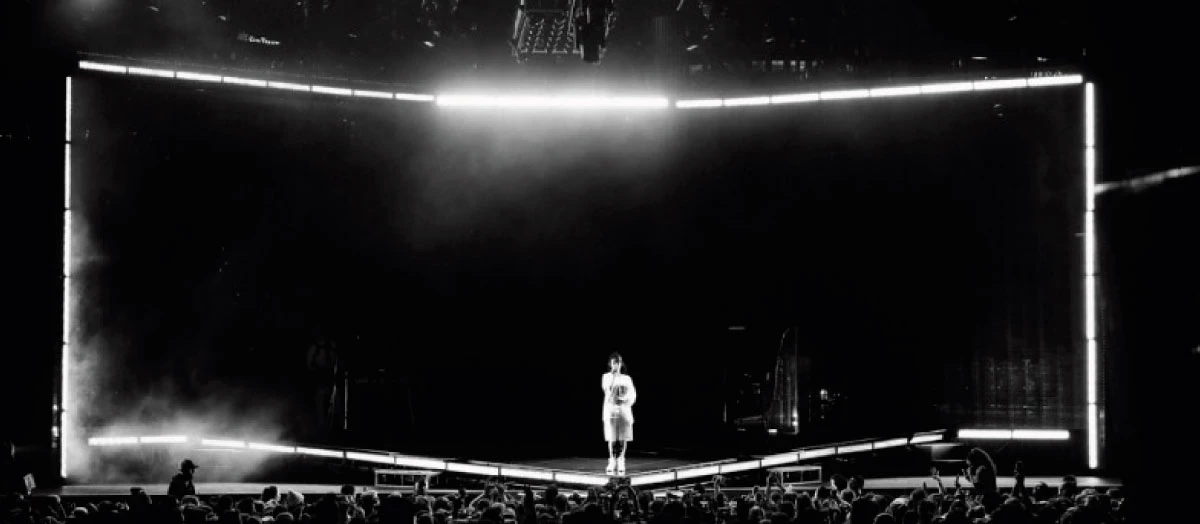
Photo credit: Melissa Madison Fuller
Timing, heavy strobing and the use of color are the three lighting elements for which Billie has a very clear vision, given she has synesthesia.
“She is quite specific in her color palette and we have to work to get the shading just right,” explains Caporale. “When she writes a song, she actually sees a color which is so crazy to think about from a lighting perspective. At the time, she’s not thinking about lights; she’s expressing a feeling.”
Billie’s music sounds different because it is, and that’s because the way she sees the world is different. She’s posted videos, explaining how she’s gone into a production session wanting to make something that “sounds like corduroy feels.” Eilish has used her synesthesia as a tool to make music that incites a physical response. She’s allowing her audience to perceive the world more like she does, by stimulating the senses in ways that blur the lines between cognitive pathways.
“On tour, we added the song ‘Bitches Broken Hearts’ and when we were programming the show, I turned the lights to red for this one, and she immediately told me it should be more of a maroon. So, on the MA2 console I just jogged my finger on the color picker and moved the shading around until she felt right, then locked in the color preset and knew we had our base hue to work with for the song.”
Caporale has learned that sometimes less is more, and that the best reward for all those hours of programming, tweaking and rehearsing is a visceral crowd reaction.
“It’s crazy how something so little can make the crowd go wild. There’s this part in that same song during the show, where Billie sings the second verse and there’s just this little “Uh” and the backlight turns to white to accent her and every single time there are girls in the front row who scream and lose their minds. It’s really cool and crazy to watch.”
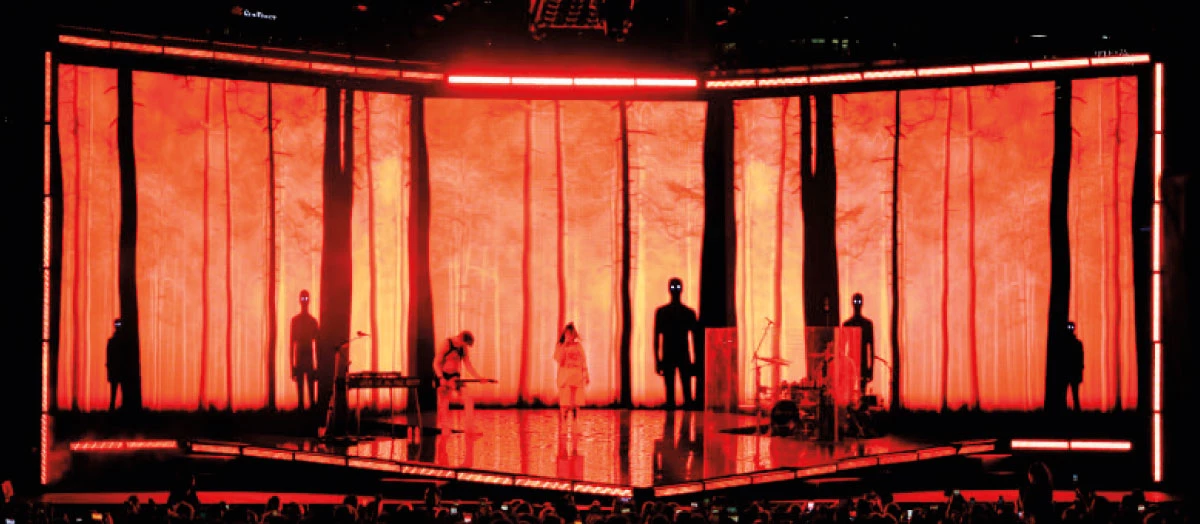
Photo credit: Melissa Madison Fuller
World Tour
“The show is insane; the fans are insane. It’s been really fun to see the phenomenon grow around her as an artist. I don’t even know how to describe it because I’ve never seen anything like it before. It’s a new teen pop idol, but a different type of pop idol,” says Caporale.
“She feels like a once in a generation artist,” agrees Anderson.
Thanks to that, the tour has been extended and will continue through November.
“This tour, because of its success, has gone to multiple continents already, and the fact that PRG has been able to support this throughout the world has been integral to our ability to extend it,” says Whitehouse. “They’ve been a really great partner to Billie and to this team.”
Production Crew:
Production & Lighting Design - Cour Design / Fireplay
Creative Director - Erik Anderson (Cour Design)
Lighting Director & Programmer - Tony Caporale
Lead Programmer - Dominic Smith
Lighting Crew Chief - Jim Keegan
Lighting Techs - William "Flash" Roger’s, Lindsey Norman, Nate Plotsky
Tour Manager - Brian Marquis
Production Manager - Bill Leabody / Nicole Massey (Leabody Inc.)
Set/Stage Designer - Cour Design / Fireplay
Stage Manager - Jayy Jutting
Video Designer - Cour Design / Fireplay
Video Content - Comix
Video Director & Disguise Programmer - Lewis Benfield
Notch Designer - Lewis Benfield
Video Techs - Tyler Thorton, Michael Boggs, Gerald "G" McDougal II
Rigger - Rai Rathor
Carpenter - Patrick O’Connell, Nate Poort
Automation - Ryan Mast
Production Companies:
Lighting & Video - PRG (Acc Rep. Anthony “Looch” Ciampa)
Staging - Gallagher Staging (Acc Rep. James Miller, Tye Trussel)
Video Content / Creator - Comix (Tom Brightman, Harry Bird, Sam Hodgkiss, Josh Gallagher, Lewis Benfield)
Trucking - Upstaging